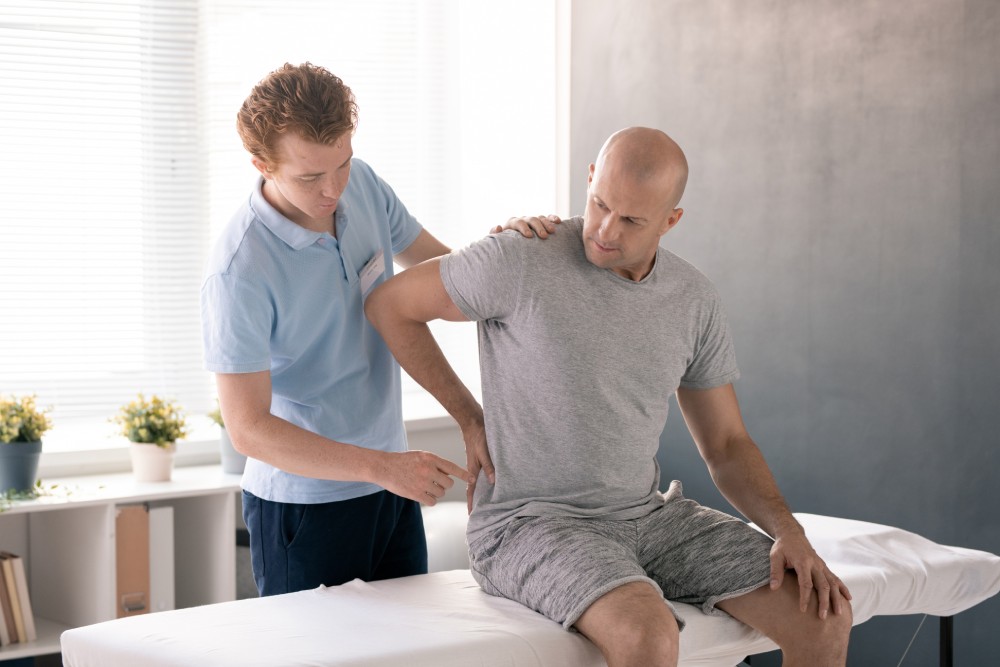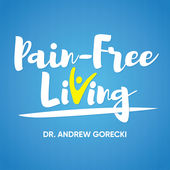
Today we're talking about the most common type of low back pain called stenosis. Stenosis is also known by other names, most commonly arthritis, and the big scary one – degenerative disc disease.
Between each segment of the spine there's a space where the nerve comes out. That space starts to get narrow as we age. That narrowing is called stenosis.
I have a really easy test that will help you understand whether or not your back pain is related to stenosis. The test is actually four questions. If you answer “yes” to all four questions, there's a ninety-seven percent chance that you actually have stenosis. The questions:
- are you over the age of 50?
- do you have pain in your back when you're standing?
- do you have pain in your back when you're walking?
- does that pain go away when you sit down?
Symptoms in addition to pain in your lower back could indicate you have sciatica stenosis. These are:
- pain that travels down our leg;
- numbness and tingling in one or both legs;
- weakness or heaviness in one or both legs.
Let's talk about the common cause of stenosis. Those openings in your spine, let's call them “spaces” are dynamic. So when you're moving one or more spaces are either opening up or closing down. The movements that make the spaces close down are actually the cause of your pain.
There's a muscle in the front of the hips called the hip flexor, which can cause the spaces in your lower spine to close down, or narrow. The hip flexor sits in the front of the hip but is attached to the spine at the last five segments, that's the lower back. The hip flexor muscle goes all the way down and wraps into the inside of the hip. When you are sitting, the muscle is totally relaxed and doing nothing. When you stand up, however, tension is placed on the hip flexor.
Sitting for long periods can be a big contributor to stenosis and lower back pain. We sit so much these days – ten hours a day for the average person. When we sit so much, the hip flexor starts to get really short and loses a lot of flexibility. When you stand up that shortened muscle pulls the spine forward, which actually closes down the spaces. When you take a step forward and you have one leg behind you, even more tension is placed on the hip flexor than when you are just standing. When it can't lengthen because it's lost flexibility, it pulls the spine forward even more and the spaces close even further.
Stenosis is a very common, especially in people over fifty. But a diagnosis of stenosis, does not mean you should be in pain. There a lot of people out there who have stenosis, but they are not having any pain. One study found that for people who showed stenosis on an MRI or x-ray, eighty percent of them over the age of fifty do not have any back pain.
The reason that these eighty percent of people with stenosis are able to live without pain is because they have good mobility in the hip flexor muscle. They're able to stand and walk without the muscle pulling on the spine. So they're able to live pain-free even though they have stenosis.
Therefore, in people with lower back pain from stenosis, we are able to relieve their pain by lengthening and increasing mobility in the hip flexor muscle.
As a physical therapist I see people in the clinic who very commonly tell me they've had back pain for months or years, even, you know, ten, fifteen, twenty years. They ask me, “when should I have come in to see you?” There is a scientific answer when it comes to that question, and it's based on the the science of healing.
There are five phases to the healing process. Phase one of the healing process is called homeostasis, or cessation of bleeding. Homeostasis takes about one to three days.
Phase two is called the inflammation phase, which lasts from about three days to twenty days. In most cases, we're actually treating inflammation in order to relieve our pain, which isn't the best idea. In fact, there are studies that show that treating inflammation only actually delays the healing process. Things that would help us treat inflammation might be ibuprofen, aspirin, or injections in the spine. All of these reduce inflammation. Yet inflammation is the second phase of healing and is a necessary part.
Phase three is granulation, and Phase four is maturation, which takes a minimum of six weeks, but can last up to two years.
So if you're struggling with pain in your back, or have that sciatic pain that travels down the back your leg oftentimes associated with pain, numbness, and tingling or weakness, there's a really good chance in the next four to six weeks it's going to go away on its own if the thing that was causing the space to close down goes away. That's really the trick. If we're only treating inflammation with drugs, it will delay the healing process. And if you're trying to wait it out and let your body heal on its own without fixing lengthening your hip flexor or increasing your mobility, it's not going to get better and remain that way.
Physical therapists are the movement experts. We're going to help you identify the movements that are closing the space down. We're not just going to mask the symptom of pain by treating inflammation, we're going to address the root cause of your back pain.
These quick exercises will help you relieve the symptom of back pain quickly by increasing mobility in the hip flexor and opening up the spaces in your spine. To watch a video with these exercises, CLICK HERE.
Exercise #1
- Sit on the front edge of a chair and simply lean forward. This will open up the spaces and decompress the nerve.
- Make sure your feet are shoulder-width apart, and gently reach down towards the ground. There is no requirement for how far you should go.
- Now gently reach back and forth with your arms stretched out in front of you for about 45 seconds. If it feels better just to hold it, you can hold it for about 45 seconds.
Repeat this two or three times several times a day and you should start to notice some relief of the pain.
Exercise #2
This next exercise will reduce the movements that are causing the space to close down. If you remember the hip flexor, the muscle that lies in the front of the spine, attaches the spine to the hip. When you stand up that muscle gets tension and when you take a step forward that muscle gets even more tension. It pulls the spine into an extended position which closes down the space, pushing on the nerve.
Use the same chair or you can use a stair. Using a stairway allows you to put your hands on the railing or the walls for extra stability. You have to make sure you're safe, and won't fall over.
- Place your foot up on the chair like you are taking a big step forward. The foot of the back leg is nice and straight, so is the other foot. Gently push your pelvis forward. You should start to feel tension right in the front of this hip. That's the hip flexor. Try pushing your hips front to back 30 seconds.
- Next move your hips gently side to side for 30 seconds.
- Then move your hips around in small circles for 30 seconds.
- Repeat these moves with the opposite leg up on the chair.
Repeat this sequence one two or three times a day, and you're going to notice that walking starts to become less painful. You're going to get relief from your back pain naturally, without medications injections and surgery. And that's the name of the game!
So if you're out there suffering with back pain and today's post made you realize it's probably stenosis related or arthritis give us a call. We have several low back pain specialists here at Superior Physical Therapy. There's no reason you should still be suffering with back pain, especially if it's been going on more than four to six weeks. Let's get you back to pain-free living!
- Dr Andrew Gorecki, DPT



